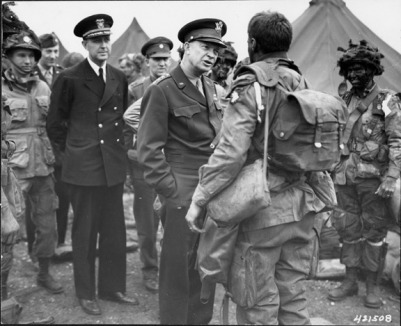"The Higgins boats broke the gridlock on the ship-to-shore movement. It is impossible to overstate the tactical advantages this craft gave U.S. amphibious commanders in World War II." -Col. Joseph H. Alexander, USMC (Ret)
(click photos to enlarge)
The LCVP (Landing Craft, Vehicle, Personnel):
A Strategic Military Innovation with Impact

LCVP loaded with troops, Landing Craft Vessels of Liberation, ca. 1944
In 1941, Higgins signed a contract to build his LCVPs, which were 36 feet long, 11 feet wide, and held a platoon of 36 fully equipped men or 12 men and a jeep.
Higgins revolutionized military strategy with his LCVPs. With the Higgins boat, soldiers could storm open, less fortified beaches, instead of attacking well-defended ports. Higgins boats played a pivotal role in enabling soldiers to secure beachheads during World War II, in all major Allied invasions including North Africa, Sicily, mainland Italy, Omaha and Utah Beaches on the Normandy coast, and Pacific islands extending to the outskirts of Japan itself. On D-day, Higgins boats transported over 34,000 soldiers to Omaha beach. Twenty-four hours after the Normandy invasion began, Higgins boats had helped transport 175,000 soldiers and 50,000 vehicles to the Normandy beaches.
The Higgins boat presented numerous innovations:
-constructed of durable veneer marine mahogany plywood
-could quickly power on and back off beaches, heading for open water
-included solid pine log in the bow acting as buffer, part of LCPL, forerunner to LCVP
-had steel bow ramp, protecting troops from gunfire and facilitating discharge of troops
-powered by a 225-horsepower, 2,000 rpm Gray diesel marine engine, reaching speeds of 12 knots
-controlled by a throttle/gear shifter, simplifying coxswain’s operations
-contained solid pine log in the bow, allowing collision with objects without sustaining hull damage
-equipped with two rudders: one for normal control and one forward of the propeller, for backing
With all these innovations, Higgins had developed a craft that could operate at maximum power in shallow as well as deep water, withstand punishing conditions at sea, and still safely and quickly deliver massive numbers of troops to the shoreline. Higgins' international acclaim eventually reached even Hitler, who dubbed Higgins the "New Noah."
Higgins revolutionized military strategy with his LCVPs. With the Higgins boat, soldiers could storm open, less fortified beaches, instead of attacking well-defended ports. Higgins boats played a pivotal role in enabling soldiers to secure beachheads during World War II, in all major Allied invasions including North Africa, Sicily, mainland Italy, Omaha and Utah Beaches on the Normandy coast, and Pacific islands extending to the outskirts of Japan itself. On D-day, Higgins boats transported over 34,000 soldiers to Omaha beach. Twenty-four hours after the Normandy invasion began, Higgins boats had helped transport 175,000 soldiers and 50,000 vehicles to the Normandy beaches.
The Higgins boat presented numerous innovations:
-constructed of durable veneer marine mahogany plywood
-could quickly power on and back off beaches, heading for open water
-included solid pine log in the bow acting as buffer, part of LCPL, forerunner to LCVP
-had steel bow ramp, protecting troops from gunfire and facilitating discharge of troops
-powered by a 225-horsepower, 2,000 rpm Gray diesel marine engine, reaching speeds of 12 knots
-controlled by a throttle/gear shifter, simplifying coxswain’s operations
-contained solid pine log in the bow, allowing collision with objects without sustaining hull damage
-equipped with two rudders: one for normal control and one forward of the propeller, for backing
With all these innovations, Higgins had developed a craft that could operate at maximum power in shallow as well as deep water, withstand punishing conditions at sea, and still safely and quickly deliver massive numbers of troops to the shoreline. Higgins' international acclaim eventually reached even Hitler, who dubbed Higgins the "New Noah."
World War II Veteran Sgt. Jacob Underwood and the LCVP
"The Longest Day," Mitch Miller, 1950



